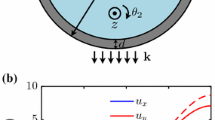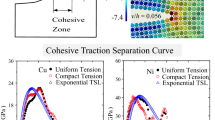Abstract
A quantitative model of environmentally sensitive crack growth of amorphous silica (a-silica) is based upon semiempirical molecular orbital (MO) calculations (AM-1 method) of a water molecule interacting with strained three- and four-fold silica rings and a five-fold ring-chain structure. The energy barrier for hydrolysis of strained 3-fold rings is only 7 kcal mol−1, the energy barrier for hydrolysis of strained four-fold rings is 29 kcal mol−1; for a five-fold ring-chain it is 39 kcal mol−1. Thus, the MO model predicts that the energetics of Region 1 slow crack growth is controlled primarily by the distribution and hydrolysis of three-membered silica rings in the a-silica structure, and Region III is controlled by the distribution and energy of contraction of four and four + membered rings.
Similar content being viewed by others
References
T. A. Michalske and S. W. Freiman, J. Am. Ceram. Soc. 66 (1983) 284.
T. A. Michalske and B. C. Bunker, J. Appl. Phys. 56 (1984) 2686.
R. J. Bell and P. Dean, Philos. Mag. 25 (1972) 1381.
F. L. Galeener, J. Non-Cryst. Solids 49 (1982) 53.
MOPAC Version 6.1, Tektronix, Inc., CaChe Scientific, Beaverton, OR (1994).
M. J. S. Dewar, E. G. Zoebisch, E. F. Healy and J. P. Stewart, J. Am. Chem. Soc. 107 (1985) 3902.
M. J. S. Dewar and C. Jie, 6 (1987) 1486.
J. K. West and S. Wallace, in “Chemical Processing of Advanced Materials”, edited by L. L. Hench and J. K. West (Wiley, New York, 1992) p. 159.
Stephen Wallace, Jon K. West and Larry L. Hench, J. Non-Cryst. Solids 152 (1993) 101.
J. K. West and S. Wallace, 152 (1993) 109.
K. D. Keefer, in “Better Ceramics Through Chemistry”, Vol. 32, edited by C. J. Brinker, D. E. Clark and D. R. Ulrich (Elsevier, New York, 1984) p. 15.
L. L. Hench and J. K. West, Chem. Rev. 90 (1990) 33.
A. G. Revesz and G. V. Gibbs, in “The Physics of MOS Insulators”, edited by G. Lucousky, S. T. Pantelides and F. L. Galeener (Pergamon, New York, 1980) pp. 92.
S. M. Wiederhorn, J. Am. Ceram. Soc. 50 (1967) 407.
John J. Mecholsky Jr and Stephen W. Freiman, 74 (1991) 3136.
Author information
Authors and Affiliations
Rights and permissions
About this article
Cite this article
West, J.K., Hench, L.L. Silica fracture. JOURNAL OF MATERIALS SCIENCE 29, 5808–5816 (1994). https://doi.org/10.1007/BF00366861
Received:
Accepted:
Published:
Issue Date:
DOI: https://doi.org/10.1007/BF00366861




